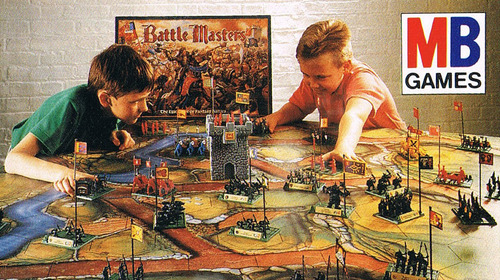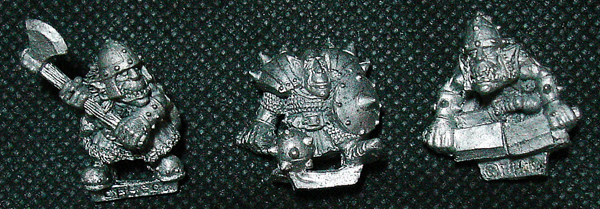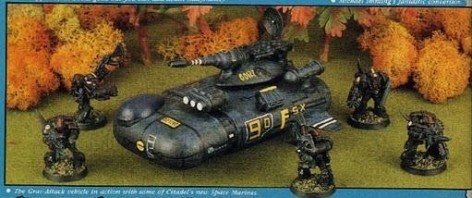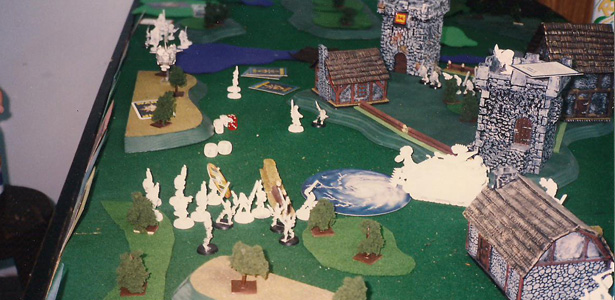Pull up a chair and sit back, I’m going to take a stroll down memory lane, and make myself feel old as I relate to you a tale of how things used to be in the world of miniatures games, and why we should return.
I have seen a lot of modern gamers talk up Games Workshop’s models as the “best around” and put down pretty much every other manufacturer out there. As GW blindly smashed apart the classic Warhammer Fantasy Battles in favor of bringing about a new game that might sell their “best miniatures in the world” better, other companies stepped up to fill the void left by the passing of that mighty game. So far, there are a few games stepping forward, with Kings of War being the early front runner.
But while Kings of War has what appear to be solid rules that also provide for a balanced game, one of the core complaints from many people is that Mantic’s models look “terrible” and thus they seem unwilling to play the game. Because clearly, as we’ve learned from Games Workshop, you can only play a game with the models produced by the company, and toy soldiers must be miniature pieces of art.
This is where I take you back in time and tell you how it used to be.
Back in the 1990s, I played Warhammer with plenty of folks, as it was rising to the top of the hill. But it wasn’t the kind of Warhammer you’d recognize today. Oh, sure, the game play was pretty similar, as the game managed to keep its core rules pretty standard over the years, a testament to how well it worked. I mean more the models that were being used to play the game.
See, Games Workshop didn’t start out with amazing works of art that would make Michaelangelo weep. Many models were one piece, and in a lot of cases there wasn’t a tremendous amount of detail. Sometimes the sculpts were a bit cartoonish. Many times they were rather basic. However, unless a figure was completely hideous, it was accepted with open arms.
Models could come from various sources. At the time, Games Workshop was still putting out various board games, such as Space Crusade or Tyranid Attack, which helped people bulk up Space Marine and Tyranid armies. But there was also the game Battle Masters, produced in conjunction with Milton Bradley. While it was a fun game in its own right (basically a miniatures battles game as a board game, with regiments and all, how cool is that?), one of the things gamers of the time loved about it was that it was a cheap way to get figures to bulk up a Warhammer army. Even better, these were GW models, and perfectly legal in events that required only GW models. Modern gamers will likely scoff at the single-pose models, but I look at the Halberdiers, Archers, Crossbowmen, and Cannons still holding spots in my Empire army, and I just see some solid figures that look just fine ranked up on the field of battle. Ditto for my Goblin Wolf Riders, or Orcs with sword and shield.

I don’t just want to make a point about how GW didn’t always have models with so much detail sculpted on that you can’t tell where to start painting. It’s also important to remember another thing about the old days: We would use non-GW miniatures in Warhammer, and quite often.
See, plenty of other companies took a stab at producing games, like Chronopia, Confrontation, or Warlords, while sometimes a company just produced 28mm fantasy miniatures because they wanted to sell them to people (either for use in battle games or RPGs). Among these were companies like Heartbreaker, who did some really cool Knights on foot that made perfect Reiksguard, or really sweet Dwarfs that put Games Workshop’s to shame. As I dug out my dad’s old Dwarfs, some of which had been assembled, to build a new Dwarf army for Age of Sigmar, I found myself unable to easily ascertain which models that’d been glued onto a slottabase were actually GW and which were Heartbreaker.

Among local gamers, and even tournaments for some time (until the Rogue Trader Tournament cycle took off), these other manufacturers were accepted in armies, and it was cool to see the variety they could add to an army. It’s somewhat ironic that Games Workshop is so vehemently against the tournament circuit that they helped create these days, because it’s that tournament circuit that really pushed other manufacturers’ models out of armies for Warhammer and 40K (to say nothing of gangs and warbands for Necromunda and Mordheim). People wanted to have “official” recognition for their events, so they demanded only GW miniatures be used, and that created an atmosphere of people expecting to see only GW models used in GW games.
I would like to promote a return to that concept. If your gaming group demands the use of a certain manufacturer’s models for playing games created by that company, ditch that rule. Allow whatever someone wants to use. Sometimes a gamer can’t afford higher priced models, and a company like Mantic might allow a new player to afford building an army they otherwise couldn’t have. Would you rather have manufacturer “purity” or a wider base of gamers to play with? Take the time to look around at other companies’ models. Maybe you see some cool basic infantry with rifles that you’d like to use to represent Imperial Guardsmen. Maybe you see a guy covered in technology and gears and think he’d be a great TechPriest.
And reverse that thinking for games as well. Want to play Kings of War but you have a Games Workshop army and don’t want to buy a Mantic army? Use your current GW models.
But take it a step further, folks. House rules have always been a fun think to use in local gaming communities. Age of Sigmar has pretty much made such rules a necessity (and seems to promote the concept). If you see some models you’d like to use in a game but can’t think of an appropriate unit for them to represent, why not try to make a set of rules for them, and run it by your friends?
Related to this same tale of “how it used to be” and how things have changed, it’s also a shame to see so many people buying into the idea that you have to buy a company’s terrain to be able to use terrain in a game. Games Workshop has become the leading example of how shameful a company can get with this, even going so far as to write rules specifically referring to their own sets of woods, so that players can’t even use homemade woods. There was a time when players made their own terrain, all kinds of terrain from whatever was lying around. One of the most popular sites of the late ’90s was called Terragenesis, with plenty of awesome articles about how to make good looking terrain with basic materials. Pringles cans, aluminum cans, even the foam trays GW models used to come in, these could all be used to make terrain that looked great, was inexpensive, and added some personality to the table.
Scratch-building doesn’t have to be restricted to terrain, either. The first edition of Warhammer 40,000 (Rogue Trader) had rules for making your own units and such, and included photos of a tank made of a deodorant stick, and another that was a modified G.I. Joe vehicle. Even as late as the early 2000s, Games Workshop still promoted this concept of scratch-built or converted models when they released the Vehicle Design Rules for 40K, showing off an updated version of the old deodorant stick grav-tank. Just because the bean counters decided to scrap that kind of stuff and push only having rules for the models they’re selling at the time, with no customization beyond that, and not allowing any other company’s models, doesn’t mean you should stick with those concepts.

Go out there, buy what you want, make what you want, and play with what you want. And if some guy can only afford Mantic models or second-hand old-school GW models, welcome him into your group anyway, because having a new gamer is a lot better than maintaining “purity” as defined by people who don’t even care about the games you’re playing.

